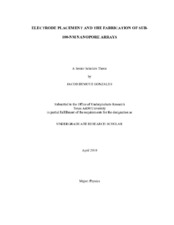| dc.contributor.advisor | Roshchin, Igor V. | |
| dc.creator | Gonzales, Jacob D. | |
| dc.date.accessioned | 2010-07-15T00:18:00Z | |
| dc.date.accessioned | 2010-07-23T21:37:32Z | |
| dc.date.available | 2010-07-15T00:18:00Z | |
| dc.date.available | 2010-07-23T21:37:32Z | |
| dc.date.created | 2010-05 | |
| dc.date.issued | 2010-07-14 | |
| dc.date.submitted | May 2010 | |
| dc.identifier.uri | https://hdl.handle.net/1969.1/ETD-TAMU-2010-05-8160 | |
| dc.description.abstract | The anodization of aluminum films grown on silicon substrates under controlled
conditions is used to fabricate porous alumina arrays. Such porous arrays are used as
sensors or lithography masks for fabrication of sub-100-nm nanodot arrays. The selfassembly
of these pores into ordered arrays is determined by anodization parameters. To
improve ordering, 2-step anodization can be used. During anodization, the electric field
produced by the anodizing electrodes affects pore growth. This field depends on the size
and shape of the electrodes as well as the distance between them. It is important that this
electric field be properly characterized so that pore development can be better controlled.
We model the uniformity of the electric field between the two electrodes using computer
simulation. Theoretical dependence of radial and vertical non-uniformity on sample
radius and electrode distance is discussed and an optimum electrode geometry is
proposed. | en |
| dc.format.mimetype | application/pdf | |
| dc.language.iso | eng | |
| dc.subject | nanopores, fringe effects, parallel plate capacitor | en |
| dc.title | Electrode Placement and the Fabrication of Sub-100-nm Nanopore Arrays | en |
| thesis.degree.department | Physics and Astronomy | en |
| thesis.degree.discipline | Physics | en |
| thesis.degree.grantor | Texas A&M University | en |
| thesis.degree.name | Bachelor of Science | en |
| thesis.degree.level | Thesis | en |
| dc.type.genre | thesis | en |
| dc.type.material | text | en |


